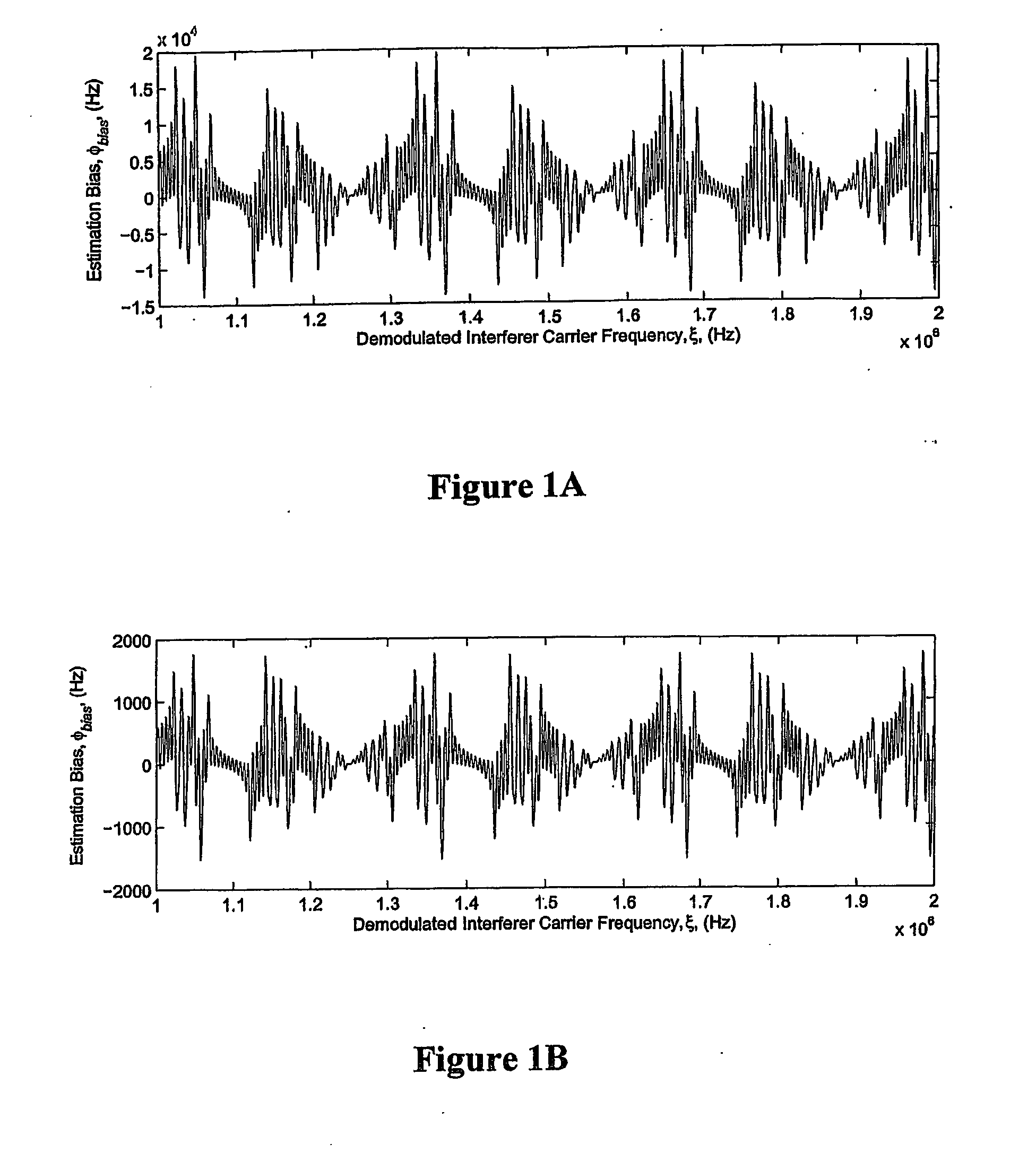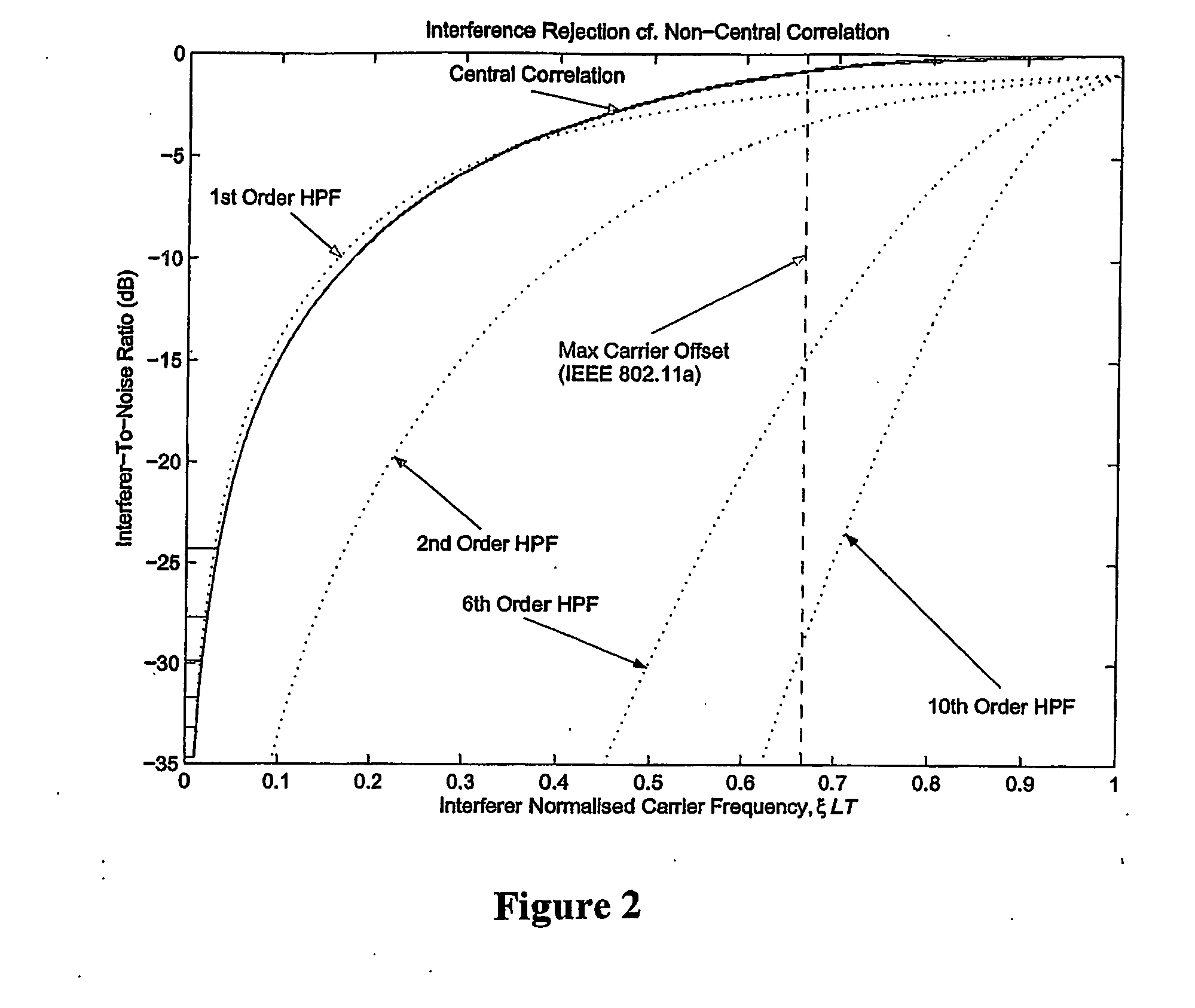Method and apparatus for improving the performance of pilot symbol assisted receivers in the presence of narrowband interference
a technology of pilot symbol and receiver, which is applied in the field of wireless communication receivers, can solve problems such as radio non-idealities, reported to be particularly sensitive to errors, and produce narrowband interferen
- Summary
- Abstract
- Description
- Claims
- Application Information
AI Technical Summary
Benefits of technology
Problems solved by technology
Method used
Image
Examples
example 1
[0104]FIGS. 3A to 3F show results for a signal to noise ratio (SNR) of 20 dB and a signal to interferer ratio (SIR) of 15 dB. FIG. 3A shows the real part of the (unfiltered) input to the pilot symbol correlator of the first receiver, while FIG. 3B shows the real part of the output from the N-LMS filter at the input to the pilot symbol correlator of the second receiver. It can be seen that the magnitude of the first 74 μs of the unfiltered signal (shown in FIG. 3A) is slightly greater than that for the N-LMS filtered signal (shown in FIG. 3B), and that the portion of both input signals containing the pilot symbol (which occupies the next 8 μs) has a magnitude which is much larger than that of the interference plus noise signal.
[0105]FIG. 3C shows the central and non-central correlation functions evaluated in the first receiver, showing that both produce high correlation for the entire time series. The correlation for the first 74 μs represents the correlation of a narrowband interfe...
example 2
[0109] The effect of more severe interference can be seen in FIGS. 4A to 4F, for a single interferer with SNR of 20 dB and SIR of 0 dB. FIG. 4A shows the real part of the (unfiltered) input to the pilot symbol correlator of the receiver, while FIG. 4B shows the real part of the output form the N-LMS filter at the input to the pilot symbol correlator of the second receiver. It can be seen that the magnitude of the first 74 μs of the unfiltered signal is much greater than that for the N-LMS filtered signal, and that the portion of both input signals containing the pilot symbol (which occupies the next 8 μs) has a magnitude that is larger than that of interference plus signal noise. FIG. 4B shows that the N-LMS filter reduces the interference at the correlator input.
[0110]FIG. 4C shows the central and non-central correlation functions evaluated in the first receiver, showing that both produce high correlation for entire time series except immediately following reception of the actual ...
example 3
[0114]FIGS. 5A to 5F show an example having a single interferer with large SNR, 40 dB, and large SIR, 30 dB. FIG. 5A shows the real part of the (unfiltered) input to the pilot symbol correlated of the first receiver while FIG. 5B shows the real part of the output from the N-LMS filter at the input to the pilot symbol correlator of the second receiver. It can be seen that the magnitude of the first 74 μs of the unfiltered signal is greater than that for the N-LMS filtered signal, and that the portion of both input signals containing the pilot symbol (which occupies the next 8 μs) has a magnitude which is much larger than that of the interference signal plus noise signal.
[0115]FIG. 5C shows central and non-central correlation functions evaluated at the first receiver. As can be seen in FIG. 5C both correlators produce a high output when the interferer is present with no pilot symbol leading to a false packet detect. FIG. 3C demonstrates that interference-only correlation (as shown in...
PUM
 Login to View More
Login to View More Abstract
Description
Claims
Application Information
 Login to View More
Login to View More - R&D
- Intellectual Property
- Life Sciences
- Materials
- Tech Scout
- Unparalleled Data Quality
- Higher Quality Content
- 60% Fewer Hallucinations
Browse by: Latest US Patents, China's latest patents, Technical Efficacy Thesaurus, Application Domain, Technology Topic, Popular Technical Reports.
© 2025 PatSnap. All rights reserved.Legal|Privacy policy|Modern Slavery Act Transparency Statement|Sitemap|About US| Contact US: help@patsnap.com



